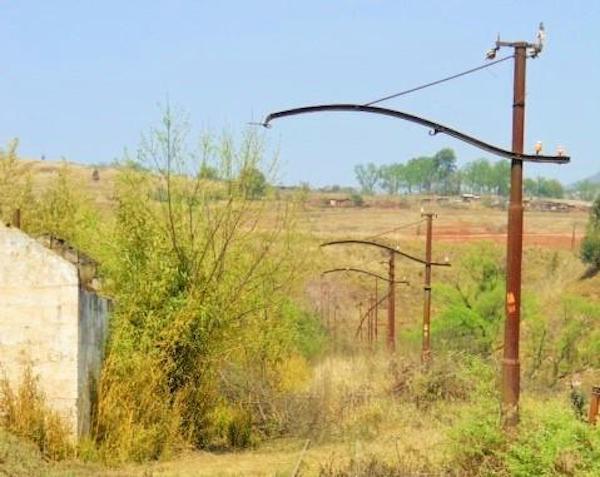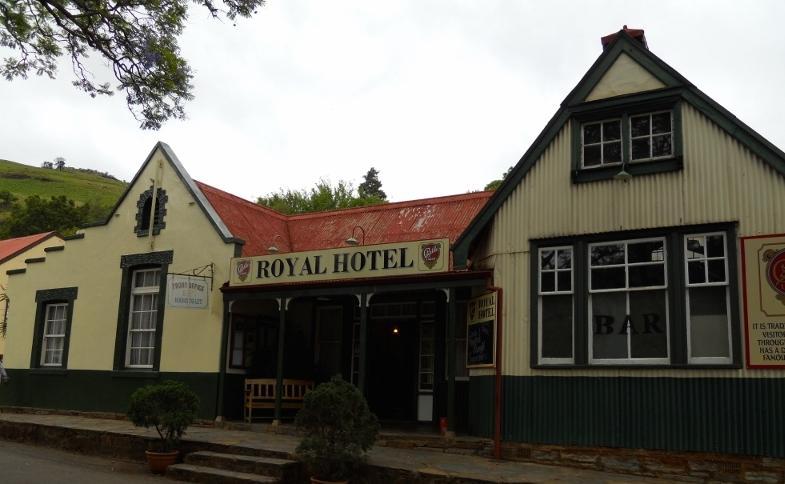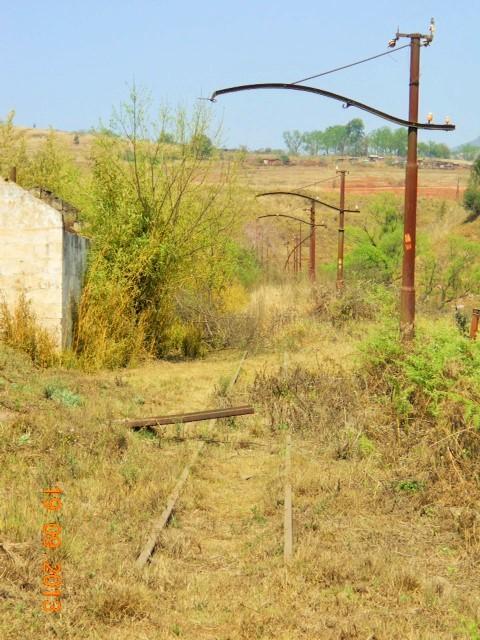
Disclaimer: Any views expressed by individuals and organisations are their own and do not in any way represent the views of The Heritage Portal. If you find any mistakes or historical inaccuracies, please contact the editor.
On reaching the bottom of Robber’s Pass on a journey towards the village of Pilgrim’s Rest, you will notice on your left the Golf Club, but should you glance to the right you will see at intervals elegant cast iron poles each with a curved outrigger. You may well ponder as to what they are and after three guesses will still be none the wiser. To know the answer you will have to know some of the history of Pilgrim’s Rest.
The first gold rush took place in 1873 when gold was found close to a waterfall, on the farm Geelhoutboom, located on the eastern Transvaal escarpment. The President of the South African Republic, President Burgers, visited the site and named the camp “MacMac” on account of the many Scotsmen who had registered their claims. The spot was proclaimed as the New Caledonia Goldfields and soon became overcrowded with diggers.
One of the diggers decided to move on and try his luck elsewhere and by pushing a wheelbarrow, containing his stores and belongings, he found a valley with a small creek that ran into the Blyde River. On panning in the stream he found rich deposits of alluvial gold. His name was Alec “Wheelbarrow” Paterson and he had found a payable gold field. Paterson tried to keep his discovery to himself, but another prospector soon followed him into the valley and struck gold. He was William Stafford and he rushed back to “MacMac” to register his claim at the Gold Commisioner’s Office. It did not take long for the word to spread and a new rush of diggers descended on the valley which was on a farm named Ponieskranz. However, the new diggings would be known henceforth as Pilgrim’s Rest and it was proclaimed a gold field on 22nd September 1873 and by the end of that year there were 1500 diggers working 4000 claims in the valley.
During the next four years the diggers worked on the recovery of the alluvial gold, from the beds of the streams and their banks, by means of sluice boxes and cradles. By 1877 the alluvial gold was petering out and many of the diggers would move away. But there was still gold locked in “them thar hills” and the simple methods of panning and sluicing which were the diggers’ methods of gold extraction (from the streams) were no longer suitable. Recovery of gold in the ground requires expensive mechanical and chemical processes which were beyond the means of the ordinary digger.
By 1881 The South African Republic had been re-instated after the Boers had won back their independence from Britain, by winning the Battle of Majuba Hill. However military victory did not equate to economic success and the coffers of the Volksraad were almost empty. In order to stimulate their ailing economy the Volksraad decided to grant concessions to private individuals and in the case of the gold fields of Pilgrim’s Rest a London financier, named David Benjamin offered to pay the sum of £ 1 000 per annum for the mining rights to the farm Ponieskrantz (on which Pilgrim’s Rest stood). The Volksraad accepted his offer with the proviso that the remaining diggers be compensated for the loss of their claims. There would be other mining operations but Benjamin would control the lion’s share.
Within two years Benjamin’s Transvaal Gold Exploration Company began its operations and the major difficulty of exploiting the gold reserves was logistical, in that Pilgrim’s Rest was located, in mountainous country remote from major habitation and although it was more or less on a route between Delagoa Bay and Pretoria (Johannesburg did not exist), the route was not a road but merely a track on which an ox-wagon could labour through the fever stricken Lowveld, to and from Delagoa Bay. The film of “Jock of the Bushveld” gives some idea of the terrible conditions that prevailed at that time. All mining equipment was brought in by ox-wagon from the coast and gold bars were taken out by stagecoach towards Lydenberg and thence Pretoria.
As time rolled by Pilgrim’s Rest became more established with the tented camp giving way to a village of corrugated iron houses and shops, the village even boasted its own hotel, the “Royal Hotel”, which is still open for guests today.
Royal Hotel Pilgrims Rest
The mine workings were spreading far and wide as new gold deposits were found further away from the original valley of Pilgrim’s Creek and by the mid 1890’s it was fully realised that an amalgamation of the gold mining interests to form one large entity would be the way ahead. And so it was that the Transvaal Gold Mining Estates Ltd. (T.G.M.E.) was formed in 1896.
The timing could not have been worse as the amalgamation coincided with the outbreak of Rinderpest epidemic, which decimated the herds of livestock along with the vital oxen. Pilgrim’s Rest’s life line was dependent on the Ox-wagon and the mines came to a near stand still through lack of supplies.
At that time the T.G.M.E. employed Mr Wertheman as consulting engineer and he was tasked with the implementation of a modernisation plan. A plan which included the building of a new central reduction works with a 60 stamp mill to replace the existing stamp mills located at the workings.
The question arose of how to bring the broken ore to the central reduction works, which was answered in a very innovative manner. Electric traction was a new form power for haulage and Werner von Siemens had been its pioneer, when from May to September 1879 he operated a short passenger carrying railway in the grounds of the Berlin Trades Exhibition. In the seventeen years since, development in electric power had progressed sufficiently to make electric traction a worthwhile proposition, especially as oxen were dying with the Rinderpest. Wertheman therefore put forward the proposal of using an electric powered tramway for the haulage of cocopans (side tipping wagons), which was approved by the Board. This now begs the question of how was electricity to be generated? The answer was by hydro-electric power. There was a small power station at the foot of Brown’s Hill, which in summer if the river was running well gave enough power to run a small mill. In winter when the river reduced its flow it would be out of action! Wertheman solved the problem by enlarging the power station and by building a water race some 2½ miles (4 km) long from higher up the river. The race was 6’-6” (2.0 m) wide by 5’-0” (1.524 m) deep and was lined throughout by iron plates riveted together. The race carried 40 cubic feet per second (68 cubic metres/minute), had a fall of 115 feet (35 metres) and could generate 362 hp (275 kW).
The tramway was a stroke of genius as it proved to be cheaper to run per ton of ore compared to a contractor’s ox-wagon. It could also run in nearly all weathers and could be extended as new mine workings were developed. The tramway had a rail gauge of 2’-6” (762 mm) and originally ran for 8 miles (13 km), which was later extended to 12.5 miles (20 km). The tramway lasted as long as the Mine Co. and when the T.G.M.E. closed in 1972 so did the tramway.
Today the mine operations are still being worked by Stonwall Mining, which has resumed the search for the elusive yellow metal at various locations around Pilgrim’s Rest.
What of the mystery of those cast iron poles by the side of the road. They are a rusty reminder of a bygone era, when they once supported the overhead power line that energised the electric locomotives (500 Volts) that pulled wagons laden with gold bearing rock to be processed at the central reduction works.
References and Further Reading
- “The History of Pilgrim’s Rest” by Judith Schultz (Information Centre)
- “Pilgrim’s Rest” booklet with photos by Deney Allen
- “Valley of Gold” by A.W. Cartwright.
- “Digging Deep” by Jade Davenport
- “How it all began, Heavy Haul – S. Africa 1897” by Roger S. Fairfax.
- “The Discovery of Wealth” Heritage Series: 19th century, by Diko Van Zyl.
- “Jock of the Bushveld” by Percy Fitzpatrick.
Comments will load below. If for any reason none appear click here for some troubleshooting tips. If you would like to post a comment and need instructions click here.


